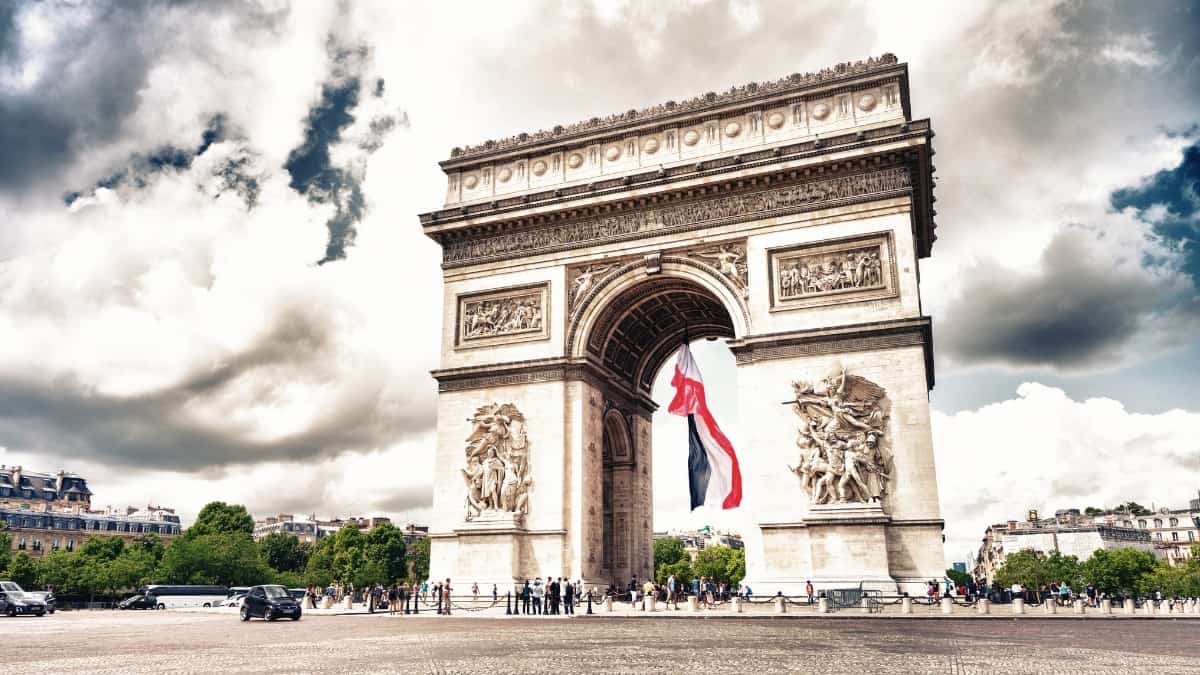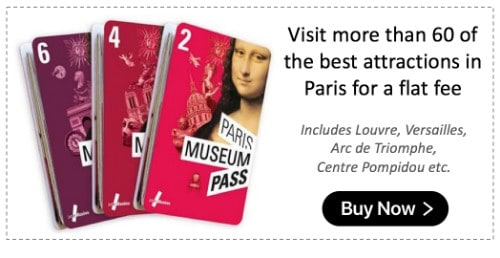
Nineteenth-century Arc de Triomphe or the Arc de Triomphe de l’Étoile is one of the most famous monuments in Paris.
This monument was designed in 1806 by renowned French architect Jean Chalgrin.
This popular Paris attraction was inspired by the Arch of Titus in the Roman Forum.
It is an iconic symbol of French victories and martyrdom of those who fought for their people and country.
Arc de Triomphe represents the martyrs in the French Revolutionary and Napoleonic Wars.
It is one of the world’s best known commemorative monuments.
Arc de Triomphe is located at the center of 12 Avenues at the end of the Champs Elysee.
Top Arc de Triomphe Tickets
Arc de Triomphe fun facts
Over the years’ lots of interesting facts about the Arc de Triomphe have emerged. Some are documented Arc de Triomphe facts and some are just legends or myths.
For example, did you know the fact that the Arc de Triomphe cost 9.3 million French Francs, a gigantic amount of money when it was constructed.
Some are academic and some are just Arc de Triomphe fun facts.
Check out some of the most interesting fun facts on Arc de Triomphe –
1. Many artists have contributed to Arc de Triomphe
It is iconic in style and decoration and has been long lauded for its historical importance.
French architect Jean Chalgrin died 1811 when the work was still incomplete.
Jean-Nicolas Huyot was commissioned to carry forward Chalgrin’ work on Arc de Triomphe.
The other major artists who contributed to this sculpture are Jean-Pierre Cortot, François Rude, Antoine Étex and James Pradier.
2. Arc de Triomphe was almost never built
Before it was Arc de Triomphe, this place was dedicated to the construction of an elephant structure proposed by French Architect Charles Ribart. It was to be a 3-level building.
Entry was to be through a spiral staircase leading to the elephant’s gut.
The furniture was to fold into the walls and the trunk was to be the drainage system of the building.
The French government denied Ribart’s this request.
3. Arc de Triomphe was commissioned on Napolean’s birthday
On August 15, 1806, the construction of Arc de Triomphe was ordered by Napoleon, the French emperor after his victory in Austerlitz.
Interestingly, this day also coincided with Napoleon’s birthday.
It was built in honor of the great French army, the Grande Armee, which was considered invincible. It had conquered most of Europe.
4. Napoleon had got a wooden replica of the Arc made
This Paris monument was only completed in 1836 during the reign of the French King, Louis Philippe.
After Napoleon’s abdication in 1814, the construction was stopped for a few years. It was resumed more than a decade later – in 1826.
However, when he was getting married in 1810, Napoleon had a wooden replica of the Arc made.
As a newly married couple, Napoleon and his wife Marie-Louise entered Paris through the wooden replica.
Before visiting, read up everything about Arc de Triomphe tickets, prices, discounts, etc.
5. Napoleon never got to see the Arc de Triomphe
Did you know the fact that it took 30 years to build the Arc de Triomphe? And that Napoleon never had the chance to see the final monument?
He finally got to pass through the Arc de Triomphe 20 years after his death.
This happened in 1840 when his body was being moved to its final resting place – Les Invalides in Paris
6. Arc de Triomphe has four major sculpture groups
The sculptures at the base of the four pillars of the Arc de Triomphe monument show 4 victories and different war scenes.
The four main sculpture groups on each of the pillars are-
Le Départ de 1792 (or La Marseillaise), by François Rude: It represents the cause of the French First Republic during the 10 August uprising. The winged personification of Liberty stands above the volunteers.
Le Triomphe de 1810, by Jean-Pierre Cortot: It represents the Treaty of Schönbrunn. Here, Napoleon is being crowned by the goddess of Victory.
La Résistance de 1814, by Antoine Étex: It honors the French resistance to the Allied armies during the War of the Sixth Coalition.
La Paix de 1815, by Antoine Étex: It honors the Treaty of Paris, concluded in that year.
Buy Arc de Triomphe ticketsVisual Story: 12 must-know tips before visiting Arc de Triomphe
7. Arc de Triomphe credits the individuals

Less important victories are inscribed on the inside walls of the Parisian monument. These walls also document the names of 558 Generals.
If the name of the General is underlined, it means he died in the battle.
Top of the arch has names of all major victories during Revolutionary and Napoleonic periods.
8. Arc de Triomphe is gigantic
The monument stands 50 meters (164 feet) in height, 45 meters (148 feet) wide and 22 meters (72 feet) deep.
The large vault is 29.19 meters (95.8 feet) high and 14.62 meters (48.0 feet) wide.
The small vault is 18.68 meters (61.3 feet) high and 8.44 meters (27.7 feet) wide.
9. Arc de Triomphe may have warned France once
This is a quirky Arc de Triomphe fact – looks like this monument has tried to warn the people of France.
The day when the battle of Verdun broke out, the sword carried by the warrior who represents France (in the Marseille relief of Arc de Triomphe) broke off.
It was covered by tarps to discourage misinterpretation by citizens as a bad omen.
However, on that day, a quarter of a million of citizens were killed, many wounded and nine French villages destroyed. Maybe it was a bad omen after all.
*The Battle of Verdun was fought from 21 February to 18 December 1916. It was the largest and longest battle of the First World War on the Western Front between the German and French armies.
10. The other side of Arc de Triomphe
Although Arc de Triomphe represents victories, it has seen its fair share of defeats too.
In 1871, Germans marched under the arch during the Franco-Prussian War.
During the German occupation of Paris in WW2, the Nazis used the Arc to their benefit.
Germans had hung a swastika flag at the Arc de Triomphe and organized military parades with a marching band on the Champs Élysées and Avenue Foch.
11. Hitler was also inspired by Arc de Triomphe
Adolf Hitler too had plans to build the world’s largest triumphal arch in Germany.
If it had been actualized, it would have been 49 times the size of Arc de Triomphe.
This monument was to immortalized 2 million names of WWI casualties on the German side.
However, the architect he had commissioned the task wasn’t sure Berlin’s soil was strong enough to hold such a massive building.
With Hitler’s permission Albert Speer built a test (he called it Schwerbelastungskörper, a load-bearing body) to see how strong Berlin’s soil was.
By the time the tests results came as negative, Hitler had already started losing the war.
Schwerbelastungskörper still exists in Berlin as a tourist attraction.
12. Charles Godefroy was the first to fly through Arc de Triomphe
The Paris attraction is so big that after World War I ended, Charles Godefroy, the French aviator made a historic flight through the Arc de Triomphe in his Nieuport fighter plane.
After the World War ended, the French Government had asked the Pilots to also march along with the Infantry through the city of Paris.
The airmen saw it as an insult and decided that one of them would fly through the Arc de Triomphe.
However, when Jean Navarre, the first-choice pilot, died during practice the responsibility fell on Godefroy. He didn’t disappoint.
13. Under the Arc lies the tomb of the Unknown Soldier

The Tomb of The Unknown Soldier from WW1 lies under the vault of Arc de Triomphe. It was placed there on 10th November 1920.
It represents the 1,500,000 soldiers who died during the war.
The inscription on the tomb of the Unknown Soldier reads: Ici Repose un Soldat Français Mort pour La Patrie 1914 – 1918.
It means, “Here lies a French soldier who died for his fatherland 1914 – 1918”.
14. The flame at the Arc has been on for almost 100 years
On 11th November 1923, Andre Maginot, French civil servant, soldier and Member of Parliament, lit the eternal flame of remembrance at the Arc.
It has never been extinguished since.
Every evening at 6:30 pm, it is rekindled and veterans lay wreaths near the flame.
Inspired by the eternal flame present on the Tomb of the Unknown Soldier, Jacqueline Kennedy requested that a similar flame be placed near her husband, President John F. Kennedy’s grave after his assassination in 1963.
Book guided tour of Arc de Triomphe15. Two assassination attempts happened at Arc de Triomphe
Two unsuccessful assassination attempts took place at the Arc de Triomphe – against Charles De Gaulle, French General, and Statesman and Jacques Chirac, Former President of France.
However, the attempts failed.
President Jacques Chirac was reviewing troops in an open Jeep for Bastille Day when a man shot at him from a hunting rifle.
Thankfully, the police took him down before he could fire again.
*This is an unbelievable fact. Did you know Charles De Gaulle had more than 25 assassination attempts on him?
16. Is de Triomphe, the largest Arc in the world?
Well, Arc de Triomphe was the largest arch in the world till 1982 when North Korea built a larger one in Pyongyang.
As of today, the Arc de Triomphe is the second largest arch in the world.
17. The Arc has one of the finest observation spots in Paris
There are 284 steps from bottom to top. An elevator is available half of the way.
However, the observation place at the very top can only be reached by climbing a few more steps even if the elevator is taken.
Just one level below the observation deck is a Museum with interactive exhibits on Arc de Triomphe’s history.
The observatory offers a panoramic view of La Défense, Europe’s largest purpose-built business district, the Basilica of the Sacred Heart of Paris, and the Eiffel tower in the background.

